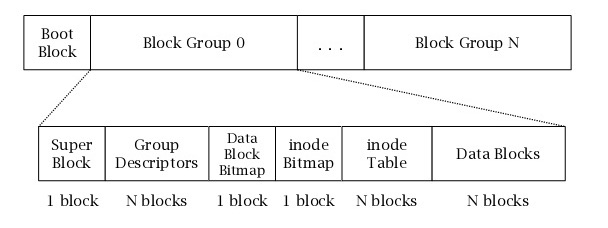Modern Operating Systems 笔记 - Linux
History of Unix and Linux
MULTICS & UNICS
- Researchers at M.I.T. joined forces with Bell Labs and Generic Electric and began designing a second-generation system, MULTICS(Multiplexed Information and Computing Service)
- One of the Bell Labs researchers, Ken Thompson wrote a stripped-down MULTICS on a PDP-7 minicomputer. The system is called UNICS(UNiplexed Information and Computing Service) jokingly by Brian Kernighan, Bell Labs.
- Thompson tied to rewite UNIX with B language of his own design and failed. Ritchie then designed a successor to B, called C. Working together, they rewrote UNIX in C.
- Steve Johnson of Bell Labs designed and implemented the portable C compiler, which could be retargeted to produce code for any resonable machine with a only a moderate amount of effort.
Standard UNIX
- AT&T released its first commercial UNIX: System III, then System V.
- Aided by U.S. Dept. of Defense, Berkeley released an improved PDP-11 called 1BSD(First Berkeley Software Distribution), which supported virtual memory, TCP/IP, vi, csh, etc.
- IEEE came up with POSIX(Portable Operating System of UNIXish), witch reconcile the two flavors of UNIX.
MINIX & Linux
- Tanenbaum wrote a Unix-like MINIX based on a microkernel design.
- In 1991, Linus Torvalds wrote another UNIX, named Linux, according to MINIX.
- Linux comes with GPL Lisence devised by Richard Stallman. GNOME, KDE were written for Linux.
Linux Goals
- Be simple, elegant, and consistent. (Wildcards, cmd abbrs, etc.)
- Power and flexibility. (every program just do one thing and do it well)
- No redundancy.
Processes in Linux
Concepts
- One PID(Process Identifier) per process, and one TID(Task Identifier) per thread.
- Child process and parent process have their own memory images respectively, and share open files.
- pipes(which can be filled and then process blocked) and signal(
killcmd, for example) are used for inter-process communication.
System Calls
forkwill create an exact duplicate of the original process(file descriptors, registers, and everything else), and applys the copy on write mechanism.execwill cause its entire core image to be replaced by the file named in its 1st parameter.waitis used to collect information and clean the zombie process left by the terminated child process.pausetells Linux to suspend the process until signal arrives.
Thread
Kernel thread is supported by Linux using clone system call.
When a thread was created, the original thread and the new one shared everything but their registers.
3 classes of threads for scheduling purposes:
- Real-time FIFO.
- Real-time round robin.
- Timesharing.
Booting
- BIOS performs initial device discovery and initialization.
- MBR is read into a fixed location and executed, which loads a standalone boot program like GRUB(GRand Unified Bootloader).
bootreads in the OS kernel and jumps to it.- Process 0 checks devices, program the clock, mount the root FS, and create
init(process 1), and page daemon(process 2). initexecs/etc/rc/*, finally opens tty and printlogin:
Memory Management in Linux
Concepts
- text segement lays in the lowest in virtual address space. It's readonly thus can be shared physically.
- data segement lays upside of text segment and contains 2 parts: initialized data and uninitialized data(called BSS(block Started by Symbol), which can grow and shrink by system call
brk). - stacks starts at the top limit of virtual address. For a 32bit x86 platform, it would be 0xC0000000.
- memory-mapped files are often used for shared libraries.
Text segment is read-only. Self-modifying programs went out of style in 1950s because they they were too difficult to understand and debug.
The existence of uninitialized data is actually just an optimization to make binary programs smaller.
Implementation
- Each linux process on a 32-bit machine typically gets 3GB of virtual address space for itself, with the remaining 1GB reserved for its page tables and other kerel data.
- The 1GB kernel memory typically resides in low physical memory but it's mapped in the top of each process virtual address space.
- Linux uses 4-level paging scheme
- buddy algorithm and slab allocator is used for memeory allocation for normal objects and kernel caches respectively.
Input/Output in Linux
File systems under the VFS includes:
- Regular file(with I/O scheduler and Block device driver)
- Block special file(with I/O scheduler and Block device driver)
- Char special file(with Optional line discipline and Char device driver)
- Network socket(with Protocol drivers and Network device driver)
- I/O Scheduler is used to reorder or bundle r/w requests to block devices.
- Line disciplines are used to render the local line editing before submit by Carriage Return.
- Linux treat drivers as loadable modules.
Linux File System
Concepts
History of Linux FS:
- The initial FS is MINIX 1 FS.
- ext FS allowed 255 chars of filename and 2GB filesize, but slower.
- ext2 allowed long filename, larger filesize, and provided better performance.
- ext3 is a follow-on of ext2 with journaling.
Linux allows directory and file locking(byte range) with semaphore, including shared locks and exclusive locks.
Implementation
4 main structures of VFS:
- superblock contains critical information about the layout of the file system.
- i-nodes each describe exactly one file.
- dentry represents a directory entry.
- file is an in-memory representation of an open file.

- With 1kb block, this design limits a block group to 8192 blocks(in practice) and 8192 inodes(not real restriction).
- Ext2 attempts to collocate ordinary files in the same block group as the parent directory, and data files in the same block as the original file i-node.
- Ext2 also preallocates a number(8) of additional blocks for that file to minimize the file fragmentation due to future write operations.
- inode contains addresses of first 12 disk blocks, single indirect, double indirect, and triple indirect when needed.
本文采用 知识共享署名 4.0 国际许可协议(CC-BY 4.0)进行许可,转载注明来源即可: https://harttle.land/2014/01/08/modern-os-linux.html。如有疏漏、谬误、侵权请通过评论或 邮件 指出。